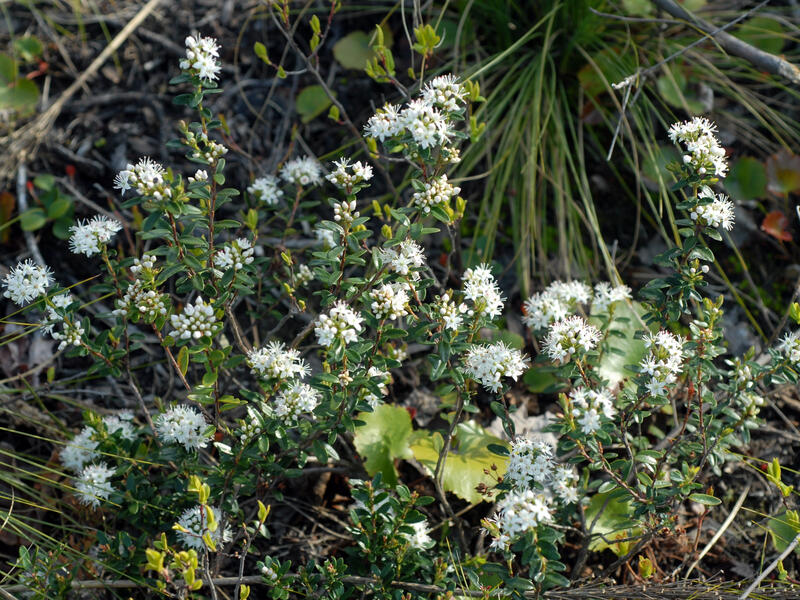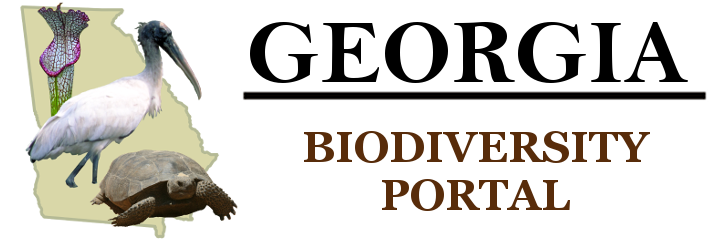







Loading profile. Please wait . . .
Kalmia buxifolia (Bergius) Gift & Kron
Sand-myrtle





Federal Protection: No US federal protection
State Protection: Threatened
Global Rank: G4
State Rank: S1
Element Locations Tracked in Biotics: Yes
SWAP 2015 Species of Greatest Conservation Need (SGCN): Yes
SWAP 2025 Species of Greatest Conservation Need (SGCN): Yes
2025 SGCN Priority Tier: High Conservation Concern
Element Occurrences (EOs) in Georgia: 3
Habitat Summary for element in Georgia: High altitude rocky ledges
Shrub usually less than 3 feet (1 meter) tall, erect or spreading, forming dense clumps or mats. Twigs are round or slightly two-angled, sticky, and hairless or with a few hairs. Leaves are up to 0.6 inch (1.4 cm) long and 0.2 inch (0.6 cm) wide, alternate or opposite, oval with slightly inrolled margins and very short leaf stalks; evergreen (shiny and dark green in summer, bronze-red in winter). The flowers are 0.4 inch (1 cm) wide, held in dense clusters at the tips of twigs, each flower with 5 white or pinkish-white petals, a red or green pistil, and 10 showy, pink-tipped stamens. The fruit is a capsule, about 0.1 inch (0.3 - 0.4 cm) long, pointed, 3-parted.
Sand Myrtle occurs at mountain sites in Georgia with other heath species such as Blueberry (Vaccinium spp.) and Huckleberry (Gaylussacia spp.); these deciduous shrubs have bell-shaped or urn-shaped flowers and larger leaves.
St. Andrew’s-cross (Hypericum stragulum), another low mat-forming shrub, has opposite, deciduous leaves and also may occur with Sand Myrtle. At Coastal Plain sites in North and South Carolina (but not Georgia, where Sand Myrtle occurs only in the mountains), Sand Myrtle may occur with low, evergreen blueberries e.g. Vaccinium myrsinites and V. crassifolium.
Molecular research suggests that Sand Myrtle belongs in the Mountain Laurel genus (Kalmia) and is therefore a close relative of Carolina Bog Laurel (Kalmia carolina), described here: https://www.georgiabiodiversity.org/portal/profile?group=plants&es_id=17684.
In Georgia, high-elevation mountain rock outcrops and ledges. Elsewhere in its range, Sand Myrtle also occurs in Coastal Plain pinelands and sandhills and on Piedmont monadnocks.
Sand Myrtle reproduces sexually by seed as well as vegetatively by producing adventitious roots at nodes on its low, spreading branches. Its flowers are pollinated by small bees, honeybees, and flies. The seeds are small and lack features such as elaiosomes that might attract insects and are probably dispersed by gravity.
Plants are most conspicuous during flowering (April–May) but the evergreen leaves and growth form are distinctive all year.
Mountains of Georgia, North Carolina, and South Carolina. Piedmont monadnocks in North Carolina. Sandy, acidic soils of the Coastal Plain in North Carolina, South Carolina, and New Jersey.
Logging or other types of clearing, conversion of habitat, construction of homes on ridges and summits, off-road vehicle use, and excessive foot traffic in high elevation habitats.
Sand Myrtle is ranked S1 by the Georgia Department of Natural Resources, indicating that it is critically imperiled in Georgia. It is listed as Threatened by the State of Georgia. Sand Myrtle has been documented at three sites in Georgia over the last century, but only one population, in the Chattahoochee National Forest, is extant.
Avoid clearing, logging, or other mechanical disturbances. Protect plants from trampling and off-road vehicle traffic. Georgia’s plants are the southernmost montane populations of this species. Plants occurring at the periphery of a species’ range are thought to be of special conservation importance. Peripheral populations are usually smaller and less genetically diverse within the population, but genetically divergent from centrally located populations. These genetic differences may confer special survival traits that plants in other portions of the species’ range lack, such as the ability to survive changes in the climate or the arrival of a new pathogen. Peripheral populations may be in the process of evolving into a new species. They are especially deserving of conservation action.
Chafin, L.G. 2007. Field guide to the rare plants of Georgia. State Botanical Garden of Georgia and University of Georgia Press, Athens.
Cullina, W. 2002. Native trees, shrubs, and vines: a guide to using, growing, and propagating North American woody plants. Houghton Mifflin Company, New York.
Foote, L.E. and S.B. Jones, Jr. 1989. Native shrubs and woody vines of the southeast. Timber Press, Portland, Oregon.
GADNR. 2020. Element occurrence records for Leiophyllum buxifolium. Georgia Department of Natural Resources, Wildlife Resources Division, Social Circle, Georgia.
Horn, D., T. Cathcart, T.E. Hemmerly, and D. Duhl. 2005. Wildflowers of Tennessee, the Ohio Valley, and the southern Appalachians. Lone Pine Publishing, Auburn, Washington.
Kron, K.A., W.S. Judd, P.F. Stevens, D.M. Crayn, A.A. Anderberg, P.A. Gadek, C.J. Quinn, J.L. Luteyn. 2002. Phylogenetic classification of Ericaceae: molecular and morphological evidence. Botanical Review 68(3): 335-423. https://link.springer.com/article/10.1663/0006-8101(2002)068[0335:PCOEMA]2.0.CO;2
Kron, K.A. and J.M. King. 1996. Cladistic relationships of Kalmia, Leiophyllum, and Loiseleuria (Phyllodoceae, Ericaceae) based on rbcL and nrITS data. Systematic Botany 21(1): 17-29. https://www.jstor.org/stable/pdf/2419560.pdf
NatureServe. 2019. Leiophyllum buxifolium comprehensive report. NatureServe Explorer. Arlington, Virginia. http://explorer.natureserve.org/servlet/NatureServe?searchName=Leiophyllum+buxifolium
Radford, A.E., H.E. Ahles, and C.R. Bell. 1968. Manual of the vascular flora of the Carolinas. University of North Carolina Press, Chapel Hill.
Strand, A.E. and R. Wyatt. 1991. Geographical variation and biosystematics of Sand Myrtle, Leiophyllum buxifolium (Ericaceae). Systematic Botany 16(3): 529-545. https://www.jstor.org/stable/2419341?seq=1#metadata_info_tab_contents
Weakley, A.S. 2015. Flora of the southern and mid-Atlantic States. University of North Carolina Herbarium, University of North Carolina, Chapel Hill. http://www.herbarium.unc.edu/flora.htm
Linda G. Chafin
L. Chafin, Apr. 2007: original account
K. Owers, Feb. 2010: added pictures
L. Chafin, March 2020: updated original account.